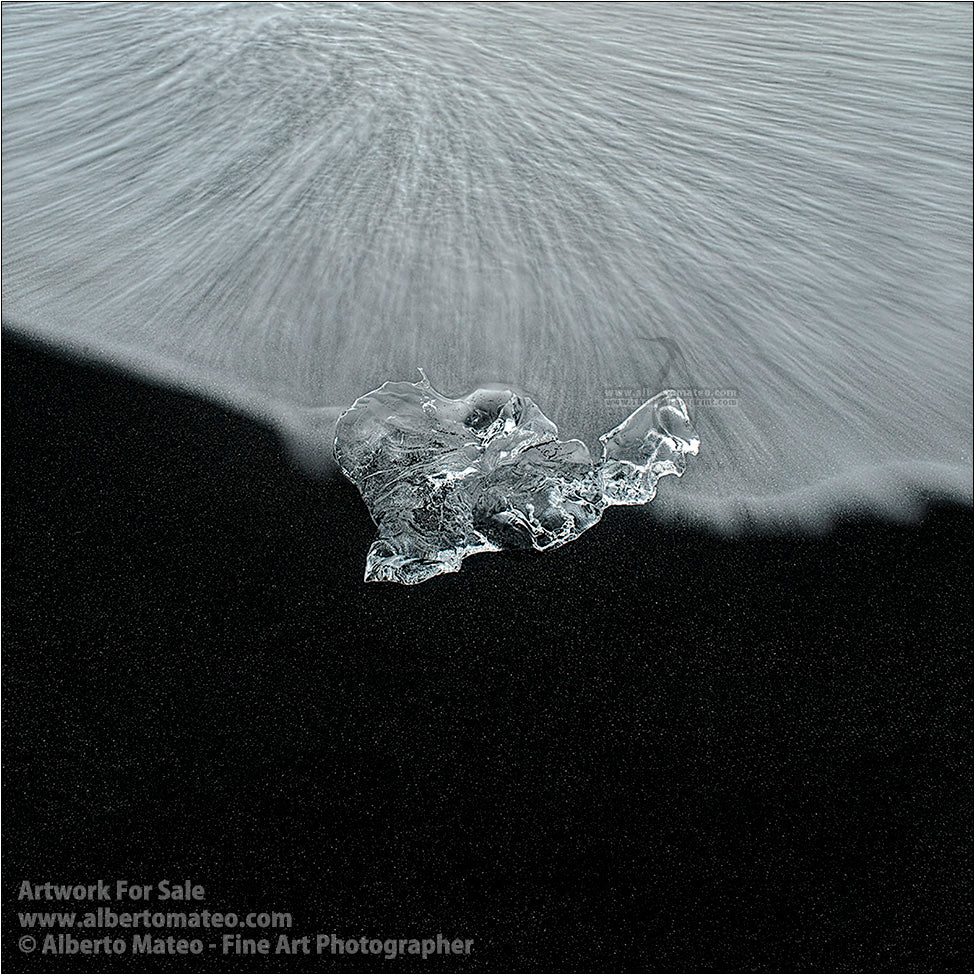Go to Diamond Beach, Iceland.
Iceland Post #5/16: Ice Block and Surf, Diamond Beach, Iceland.
You can see a full-size version of this image at my site…
[Length: 768 Words | Reading time: 3 min 45 seconds]

In some special locations, usually very cold ones, the elements like water create beautiful natural shapes when they change into different states: the most common one, flowing water as can be seen in my Skogafoss picture, clouds (please check my previous post), or ice.
Jokulsarlon is one of the main touristic and photographic valued attractions in Iceland, and the nearby Diamond Beach, where the icebergs are dragged to melt definitely has a different inherent grandeur that can be compared with the lagoon itself.
This glacier lagoon is formed when glacier Breidamerkurjökull, which collects the snow that falls in the center of Iceland, approaches to the sea where the temperature is lower and begins to melt, breaking into ice blocks that separate from the main mass of ice. These icebergs are dragged by the current to the open sea, but the tide sends them back to earth placing on the black volcanic sand of ‘Diamond Beach’. Once there, the ice is dragged back and forth over the sand by the waves, until the chunk melts definitively.
As a photographer I can say that the show is amazing: shiny shapes of ice that glitter over the contrasting black sand. They simply look impressive in a photograph. A subject any landscape photographer would love to photograph.
For this image I chose a closed minimalist composition with only three subjects: the ice in the middle, a receding wave, and black volcanic sand.
Related Images: Pictures taken during winter conditions
It was cloudy the day I took this image. It was raining and hailing intermittently and the ice block was backlighted by a cloudy sky with a soft illumination that produced no shadows, but made glitter the shapes over the sand.
I tried some lenses to arrange a composition: the Nikon 50mm f1.8 AF (the framing was ‘too closed’), the Nikon 20mm f2.8 AF (the angle of view was too open, too much of the surroundings could be seen around the ice chunk), but the best composition was produced by my Nikon 24mm f2.8.
This is maybe my favorite lens: it is so small, light, easy to use, its depth of field is so wide, its sharpness is incredible, and the angle of view is my favorite to shoot landscapes. 20mm is a bit too open, 28mm a bit too closed for my taste. Did I have to choose only one lens to carry with me it would be by far this tiny optical wonder.
I chose a slow shutter speed that produced a silky look in the waves and closed down to f11 to have plenty of depth of field (out of focus objects would have added nothing to this photograph). With those settings (1.3 seconds; f11) I needed an ISO setting of 200. I could have pushed up the ISO even more, to 400 or even 800 with the sensor of my Nikon D800, one of the best ones in the market to shoot under low light conditions even having regard to its age, 6 years, which can be considered an eon when talking about technology.
Needless to say a tripod is an absolute must in this type of photographs. There are two main reasons:
- It allowed me to balance the composition, which is not easy with waves that are approaching the camera and receding continuously.
- It would be impossible to get everything sharp with a long exposure of more than 1 second.
My sturdy Manfrotto 055 Pro with a Gitzo 1372M Magnesium Alloy Head is heavy enough to maintain a fixed position even with waves touching the lower parts of the legs, and sometimes moving them. The force of the waves is very variable in Iceland. Some of them barely touch the legs, while others may move it or make it fall to the ground. Working with your tripod legs inside the sea is, to say the least, tricky; I will write soon a post about it.
I take the opportunity to say that I miss very few of the features that the last models of cameras (mirror-less included) marketers are proud to shout to the four winds. The Nikon D800 is perfectly usable and a wonderful camera to buy even today at a fraction of the original price. In fact, it is much cheaper than the newer models D810, D850 and Z7, which do not add, at least for me, many features that can make a real difference.
Related Images: Volcanic landscapes taken in the nearby Faroe Islands
EXIF DATA:
Camera Model: Nikon D800
Lens: Nikon 24mm AF-D
SETTINGS: Aperture: f11 | Shutter Speed: 1.3 seconds | ISO 200
LIST OF USED GEAR
Tripod: [Legs: Manfrotto 055 Pro] & [Head: Gitzo 1372M Magnesium Alloy]
Backpack: LowePro with rain cover (absolutely needed in Iceland)
Filter: B+W 77mm Graduated 0.6 Neutral Density Filter 2 points, soft transition
Memory Card: Sandisk SD Extreme 64Gb
NEXT SCHEDULED POST: Clouds over Petursey, Vik, Iceland.
Have you liked this post? If so you can SUBSCRIBE to The Last Footprint to receive the last updates, learn photography and get travel tips. It is FREE and you can unsubscribe whenever you want.
This image is available as an Open Edition Fine Art Print. Click here to visit the shop.


0 comments